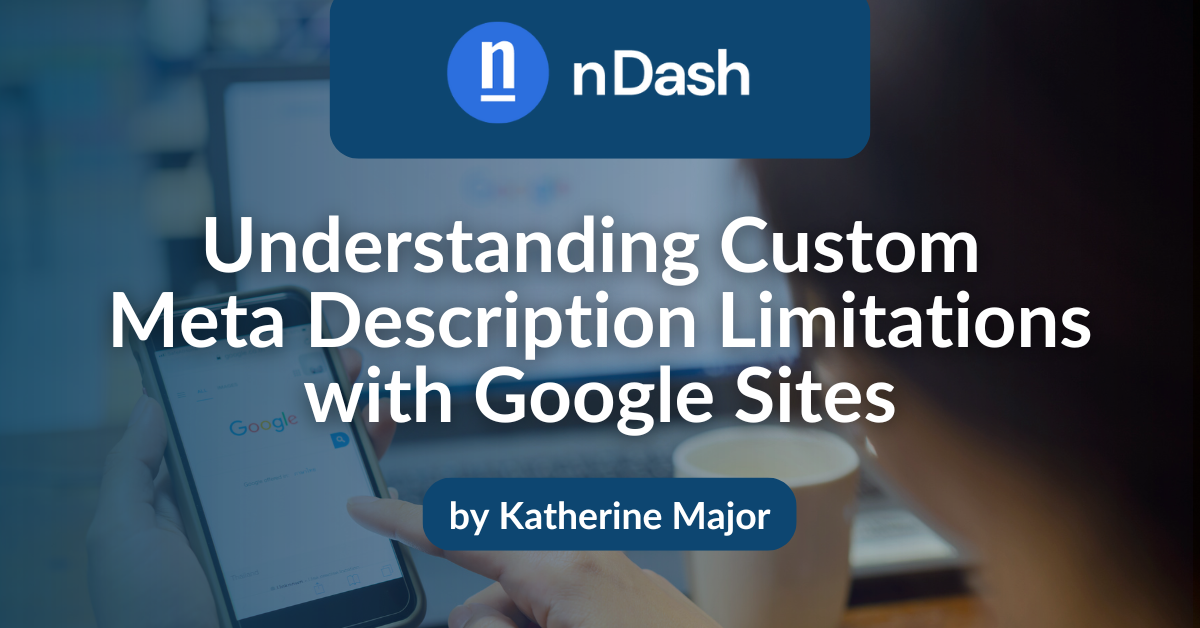Imagine a world where Google—the iconic pioneer of web search—doesn’t allow users to input meta descriptions on their own products. Well, we’re in one.
Not long ago, a member of our nDash team helped their spouse build a small, basic website using Google Sites. It’s a no-code web builder that’s easy to use for both team intranet and brand website projects.
As any good marketer does, they ran the website through Ahrefs to see how it could be improved for SEO. However, they found that they weren’t able to follow Ahref’s recommendation to add meta descriptions for each page. Put simply, Google Sites does not have this option.
In this article, we’ll unpack why Google made this choice and what we should read into this notable omission.
The Power of the Meta Description
As scrollers and marketers alike, we know that meta descriptions are hugely important. Meta descriptions help users decide whether to tap the link (and thus have a big impact on click-through rates).
A good meta description will help users save time and find the answers most relevant to their search. Google has taken pains to perfect this important concept over the years.
Google for Developers even has a dedicated article on meta description best practices. It defines meta descriptions as “A meta description tag generally informs and interests users with a short, relevant summary of what a particular page is about. They are like a pitch that convinces the user that the page is exactly what they’re looking for.”
It’s interesting that Google compares meta descriptions to a sales “pitch” but doesn’t include this capability in its own tool.
Do Meta Descriptions Help Content Ranking?
Google has long maintained that meta descriptions do not directly impact search engine rankings. Yet, that’s not exactly the end of the story and does not fully explain why meta descriptions matter.
If a meta description compels a user to click on the link, this will impact the click-through rate.
Then, the quality of the content determines how much time the user spends on the page. This tells Google about the quality of the website and content and how well the website answered the query.
You can easily see how a compelling meta description and a high click-through rate can indirectly boost ranking performance. Notably, though, the click-through rate does not directly impact search engine rankings.
When Did Google Sites Make This Change?
It’s difficult to source the exact date of the decision to remove custom meta description capabilities in Google Sites. Yet, a notable Google support thread asking for assistance in adding meta descriptions surfaced in 2019.
In the thread, Google’s automated SEO optimization tool, Google Lighthouse, was mentioned. The irony of the program flagging pages without a meta description during web page audits was particularly pointed out. Lighthouse still does this to this day.
Users also remarked that if Google isn’t letting them provide custom meta descriptions on Google Sites, are they important anymore?
A Strong Push for Good Content
So, why did Google do this? Why remove the ability to create our own custom meta descriptions in its very own web builder tool? Especially when it’s so well established that meta descriptions have an indirect impact on ranking factors?
Two words: Good content.
Ultimately, we can argue for the usefulness of meta descriptions all day long. Yet, they do not mean much if the page content doesn’t follow Google’s principles of E-E-A-T.
Now, E-E-A-T includes other factors, like brand awareness and trust, as well as technical SEO considerations, such as HTTPS and SSL certificates. However, good content is the leading driver.
Putting People First
Google takes a people-first approach to ranking. This means that it ranks content that is ultimately created to benefit the public with trustworthy, reliable content.
Even after evaluating based on their SEO best practices and several different ranking factors, it still only prioritizes content it deems most helpful.
That means you could be missing key SEO ranking elements but still rise in the SERPs. It all comes down to how helpful Google deems your content to be.
Their official article on this subject even mentions that proper SEO efforts can help. But ultimately, “…when it is applied to people-first content, rather than search engine-first content.”
Custom Meta Descriptions Won’t Replace Good Content
Notably, in the aforementioned SEO best practices article, Google includes using meta descriptions.
Ultimately, it seems the quest for helpful content outweighs the need for a custom meta description for the search engine giant.
Which, if you think about it, makes sense.
So, while meta descriptions are still important, they’re not as important as a clear, well-written, and informative piece of content. A piece of content that ultimately answers the search query.
If you’re using Google Sites, remember that Google will still pull a meta description from the page content. They may even change it periodically depending on how useful they think it will be to the user.
About the Author

 Katie Major is a versatile marketing professional with a passion for content creation and strategic storytelling. She leads creative initiatives as Lead Creative at Major Marketing and serves as a Content Strategist and Copywriter at Katherine Major Creative. To learn more about Katherine — and to have her write for your brand — be sure to check out her
Katie Major is a versatile marketing professional with a passion for content creation and strategic storytelling. She leads creative initiatives as Lead Creative at Major Marketing and serves as a Content Strategist and Copywriter at Katherine Major Creative. To learn more about Katherine — and to have her write for your brand — be sure to check out her